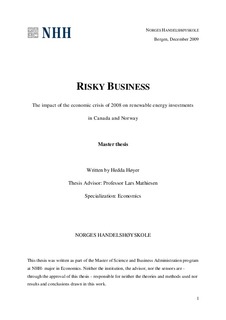Risky business: the impact of the economic crisis of 2008 on renewable energy investments in Canada and Norway
Master thesis
Permanent lenke
http://hdl.handle.net/11250/169161Utgivelsesdato
2009Metadata
Vis full innførselSamlinger
- Master Thesis [4372]
Sammendrag
The economic crisis of 2008 brought uncertainty to all markets. As credit markets experienced growing constraints on liquidity, debt financing became increasingly difficult to find. This had a greater impact on some industries than on others. In the summer of 2008 wind power and solar power were closer than ever before to being economically viable due to soaring energy prices. RE investments are characterized by a high degree of debt financing and high risk exposure, and when the energy prices started to decline, a credit squeeze put renewable energy (RE) investments to a full stop.
A discounted cash flow analysis and a subsequent sensitivity analysis of the critical parameters show that the profitability of RE projects is sensitive to changes in the investment cost and the electricity price. Due to high investment costs, changes to e.g. commodity prices are expected to have a great impact on the economic viability of RE projects. Political incentives targeting the price, at which the electricity generated from renewable sources can be sold, will also be successful.
Low interest rates have contributed to lower financing costs for RE projects. However, the crisis brought increased uncertainty and higher risk exposure to all industries. This uncertainty caused the total costs of financing to increase due to demands for higher equity shares and larger risk premiums. This has affected the profitability in the RE sector more than the reduction of risk free interest rates.
